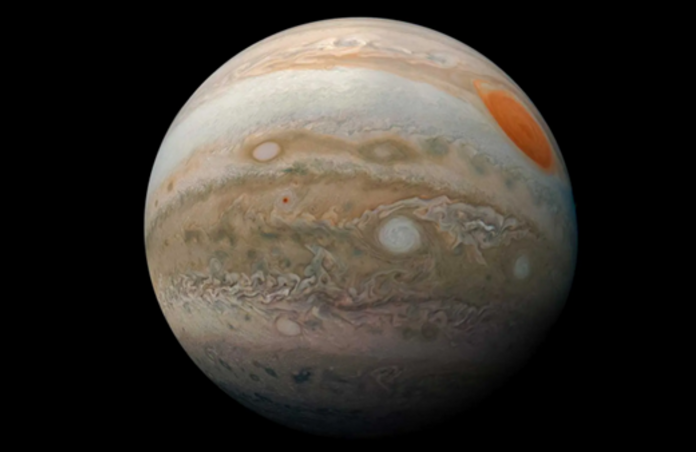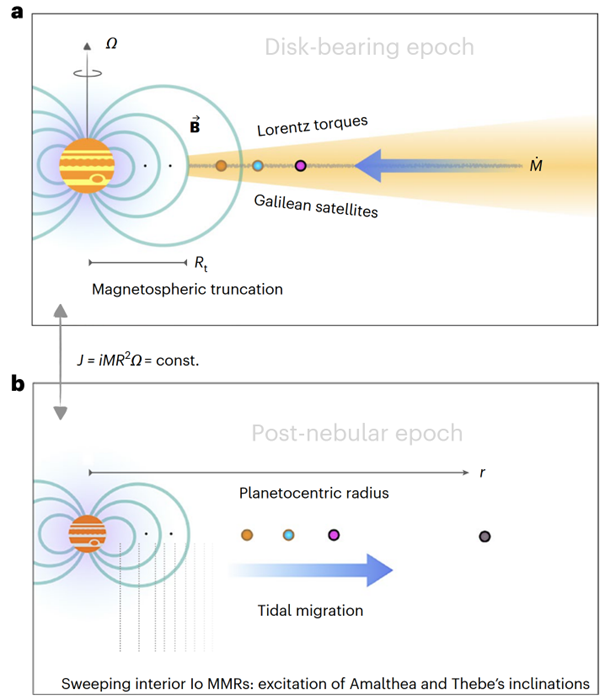Dynamical Constraints on Jupiter’s Primordial Size and Magnetosphere

As a young protostar forms, angular momentum conservation dictates that any small rotational terms are amplified under contraction. A consequence is that the spherical material surrounding the main body is flattened due to centrifugal forces. This forms a protoplanetary disk. Within this region, microscopic dust grains accumulate into planetesimal objects and eventually the solid core of a planet. From here, the core can sustain smaller bodies in its orbit as well as accrete some of the surrounding gas into a permanent atmosphere.
Eventually, the major bodies of the solar system settled into a state of dynamical stability. Accretion onto planets and photoevaporation by solar radiation resulted in the dissipation of the interplanetary medium, preventing any further growth. Many studies that investigate the history of our solar system hinge on this early phase, on the precise states of planetary bodies before a period of relative quiescence. However, studies that aim to determine these parameters rely on modelling the accretionary period directly. This introduces many inherent uncertainties in the derived initial state.
Now, a study led by Konstantin Batygin aims to circumvent any assumptions and derive some of Jupiter's key, primordial parameters relying solely on modern, dynamical evidence. As the most massive non-stellar object in the solar system, Jupiter played a dominant role in shaping the planetary orbits. As such, identifying its primordial state is key to understanding the early evolution of the solar system as a whole. Batygin et al’s study focusses on two distinct approaches to pinning down its radius and magnetic field strength during this initial period.

The first part of their analysis focusses on the dynamics of Jupiter’s inner moons Amalthea and Thebe, which have slightly inclined orbits relative to Jupiter’s equatorial plane. These inclinations are thought to have arisen from gravitational resonances with Io, another Jovian moon, during a period of outward migration. In doing so, Io will have crossed a series of mean-motion resonances (MMRs) with the inner moons. Each resonance passage could have “kicked” the inclination of a nearby moon. By developing analytical models of their interactions, the authors estimate the expected inclination changes for different resonances and compare them to the observed orbital tilts. This allowed them to identify which resonances Io must have crossed, thereby constraining its orbital radius at the time of gas disk dispersal.
The initial location is assumed to correspond to the magnetospheric truncation radius, which can be seen in Figure 1. as Rt. This is a shell where the planet's magnetic field dominates the motion of surrounding gasses, channelling any inflowing material along field lines towards the poles. Knowing this radius, the authors calculate the magnetic field strength required to truncate the disk at that location.
The second phase of investigation examines the evolution of Jupiter’s rotation during its late accretion phase. At this stage, the planet’s spin was governed by a balance between opposing processes. The accretion of material and gravitational contraction both acted to increase the rotation rate as a result of angular momentum conservation. Meanwhile, magnetic braking, arising from the interaction between Jupiter’s strong magnetic field and the ionized gas in its surrounding circumplanetary disk, exerted a torque that slowed the planet’s rotation. By assuming that this rotational equilibrium persisted until the dissipation of the gas disk and then applying angular momentum conservation from that point to the present day, the authors can reconstruct Jupiter’s primordial radius at the end of its formation.
The results of their investigation find that Jupiter’s initial radius was around 2 – 2.5 times greater than its modern value. Likewise, they find the magnetic field strength to be around 21 mT, or 50 times as stronger than today.
--
Journal Source: K. Batygin and F.C. Adams, Determination of Jupiter’s primordial physical state, Nature Astronomy, (2025), DOI: https://doi.org/10.1038/s41550-025-02512-y
Cover Image Credit: NASA/JPL-Caltech/SwRI/MSSS
